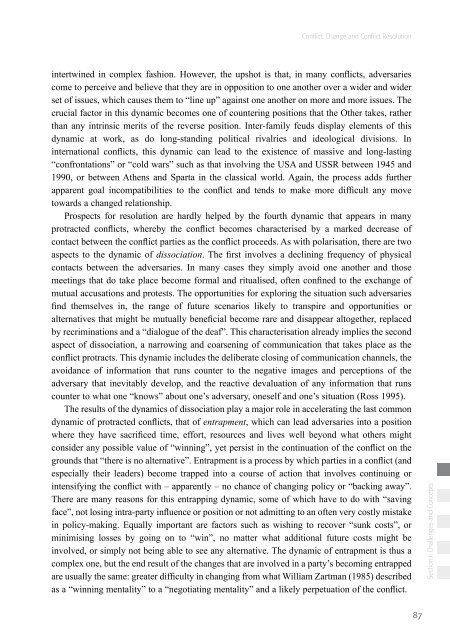Conflict, Change and Conflict Resolution - Berghof Handbook for ...
Conflict, Change and Conflict Resolution - Berghof Handbook for ...
Conflict, Change and Conflict Resolution - Berghof Handbook for ...
Create successful ePaper yourself
Turn your PDF publications into a flip-book with our unique Google optimized e-Paper software.
<strong>Conflict</strong>, <strong>Change</strong> <strong>and</strong> <strong>Conflict</strong> <strong>Resolution</strong><br />
intertwined in complex fashion. However, the upshot is that, in many conflicts, adversaries<br />
come to perceive <strong>and</strong> believe that they are in opposition to one another over a wider <strong>and</strong> wider<br />
set of issues, which causes them to “line up” against one another on more <strong>and</strong> more issues. The<br />
crucial factor in this dynamic becomes one of countering positions that the Other takes, rather<br />
than any intrinsic merits of the reverse position. Inter-family feuds display elements of this<br />
dynamic at work, as do long-st<strong>and</strong>ing political rivalries <strong>and</strong> ideological divisions. In<br />
international conflicts, this dynamic can lead to the existence of massive <strong>and</strong> long-lasting<br />
“confrontations” or “cold wars” such as that involving the USA <strong>and</strong> USSR between 1945 <strong>and</strong><br />
1990, or between Athens <strong>and</strong> Sparta in the classical world. Again, the process adds further<br />
apparent goal incompatibilities to the conflict <strong>and</strong> tends to make more difficult any move<br />
towards a changed relationship.<br />
Prospects <strong>for</strong> resolution are hardly helped by the fourth dynamic that appears in many<br />
protracted conflicts, whereby the conflict becomes characterised by a marked decrease of<br />
contact between the conflict parties as the conflict proceeds. As with polarisation, there are two<br />
aspects to the dynamic of dissociation. The first involves a declining frequency of physical<br />
contacts between the adversaries. In many cases they simply avoid one another <strong>and</strong> those<br />
meetings that do take place become <strong>for</strong>mal <strong>and</strong> ritualised, often confined to the exchange of<br />
mutual accusations <strong>and</strong> protests. The opportunities <strong>for</strong> exploring the situation such adversaries<br />
find themselves in, the range of future scenarios likely to transpire <strong>and</strong> opportunities or<br />
alternatives that might be mutually beneficial become rare <strong>and</strong> disappear altogether, replaced<br />
by recriminations <strong>and</strong> a “dialogue of the deaf”. This characterisation already implies the second<br />
aspect of dissociation, a narrowing <strong>and</strong> coarsening of communication that takes place as the<br />
conflict protracts. This dynamic includes the deliberate closing of communication channels, the<br />
avoidance of in<strong>for</strong>mation that runs counter to the negative images <strong>and</strong> perceptions of the<br />
adversary that inevitably develop, <strong>and</strong> the reactive devaluation of any in<strong>for</strong>mation that runs<br />
counter to what one “knows” about one’s adversary, oneself <strong>and</strong> one’s situation (Ross 1995).<br />
The results of the dynamics of dissociation play a major role in accelerating the last common<br />
dynamic of protracted conflicts, that of entrapment, which can lead adversaries into a position<br />
where they have sacrificed time, ef<strong>for</strong>t, resources <strong>and</strong> lives well beyond what others might<br />
consider any possible value of “winning”, yet persist in the continuation of the conflict on the<br />
grounds that “there is no alternative”. Entrapment is a process by which parties in a conflict (<strong>and</strong><br />
especially their leaders) become trapped into a course of action that involves continuing or<br />
intensifying the conflict with – apparently – no chance of changing policy or “backing away”.<br />
There are many reasons <strong>for</strong> this entrapping dynamic, some of which have to do with “saving<br />
face”, not losing intra-party influence or position or not admitting to an often very costly mistake<br />
in policy-making. Equally important are factors such as wishing to recover “sunk costs”, or<br />
minimising losses by going on to “win”, no matter what additional future costs might be<br />
involved, or simply not being able to see any alternative. The dynamic of entrapment is thus a<br />
complex one, but the end result of the changes that are involved in a party’s becoming entrapped<br />
are usually the same: greater difficulty in changing from what William Zartman (1985) described<br />
as a “winning mentality” to a “negotiating mentality” <strong>and</strong> a likely perpetuation of the conflict.<br />
87<br />
Section I: Challenges <strong>and</strong> Concepts
















